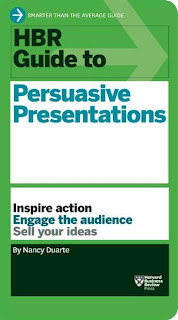What does this book contain?
 This book is a primer on presentations. It touches upon every topic which every presenter needs to know. The book describes the following 7 step process of making any presentation:
This book is a primer on presentations. It touches upon every topic which every presenter needs to know. The book describes the following 7 step process of making any presentation:Know your audience -> Develop your message -> Use storytelling to engage the audience -> Identify the best medium to communicate the message (software or otherwise) -> Design your slides -> Deliver your presentation -> Measure and increase the impact of your presentation.
Who is this book for?
If you have never read a book on presentations, you should start with this. Since the book has tried to cover everything about a presentation, it does not go too deep into anything. In a way, that is good for the reader. The book is full of stuff which will make you way better than you currently are.
If you like the book and wish to study more then you can pick up books which explore individual parts of the presentation process in more detail. For example, to read more about how to deliver a presentation, you can check out 'Confessions of a Public Speaker'.
What I liked about this book?
- It is a quick read.
- It covers every aspect of making a presentation. So you get the total picture.
- I agree to the beliefs and principles shared in the book.
Here are a few thoughts which Nancy Duarte has about how to make presentations. I fully subscribe to these:
- Your audience is the hero of your presentation. So spend time understanding them first. Start by asking who is the audience and what I can do for them.
- Presentation is serious business. You will only succeed if you are willing to take the pain and put in the effort. There are no short-cuts.
- See the bigger picture. You need to start your planning from the objective and the main message and then go deeper into how to support your message. The software comes last. It might not even come at times.
- Every step matters. Every step of your presentation process is equally important. Give due thought at every step.
- Stories are the best way to communicate. Stories make your message memorable and make it easier to spread.
- PowerPoint is just a tool. It is an aid to help you communicate your message better. Do not overestimate its role and do not make it the centre of your presentation. You are more important than your slides.
Reading the book will ensure you understand what a presentation really is. This book will make you ask the right questions to yourself while making a presentation.
What could be better?
The book moves at a rapid pace and does not dig deeper into any subject. While that seems fine overall, at many places you will crave for more examples and more information. How do I do this? Why this not that? The author could have added links to TED videos or more content online for interested readers. This book needs to be followed up by the following books:
What's the final word?
Recommended. I give it 4 stars out of 5. It will not teach you everything, but will teach you something about everything. You are then free to explore further.
This book clearly describes in a step-by-step approach, what to do and why. I found reading this to be so helpful to conceptualize and design my talk.
ReplyDelete